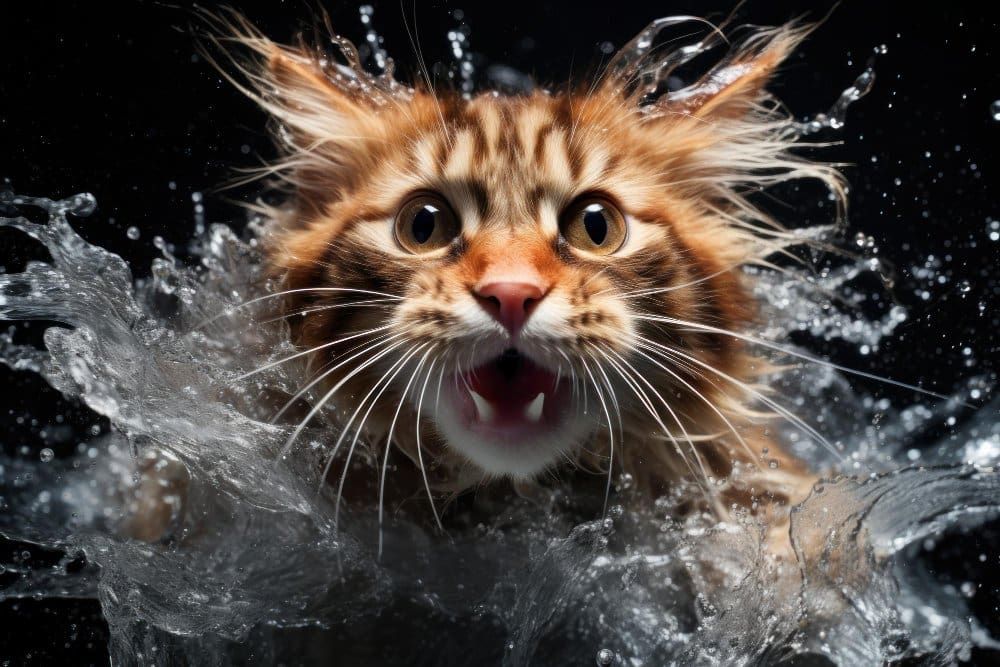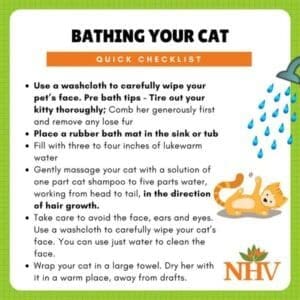Cats And Water Imagine a stress-free bath time for you and your cat. We demystify the process and provide tips to ensure your furry friend stays clean and calm. Discover proper techniques for bathing, drying, shampoo selection, and aftercare. Learn how to gradually introduce your cat to water for a peaceful experience that leaves you both happy.
Why do cats hate water?
Cats have long been associated with a dislike for water, but have you ever wondered why? There are several reasons why our feline friends may harbor an aversion towards water, and they can be traced back to evolutionary, sensory, and psychological factors.
Evolutionary reasons
Cats, as natural predators, are equipped with the necessary physical attributes to excel on land. Their bodies are built for agility and speed, with specially adapted claws and muscles that enable them to climb, pounce, and hunt prey effectively. Unlike their aquatic counterparts, such as otters, cats do not possess the same level of physical adaptations for swimming. This evolutionary heritage could explain why many cats instinctively shy away from water.
Sensitivity to temperature
Another possible reason for cats’ dislike of water is their sensitivity to temperature. Cats have a higher body temperature than humans, and exposing their bodies to cool or cold water can be uncomfortable for them. The sudden drop in temperature can be a shock to their sensitive systems, causing distress and prompting them to avoid water at all costs.
Lack of control and vulnerability
Cats are known for their independent and self-reliant nature. When submerged in water, however, they may feel a loss of control and vulnerability. Unlike on land, where they can easily maneuver and escape if needed, cats can feel restricted and trapped in water. This loss of control can cause them significant anxiety and stress, reinforcing their dislike for water.
Understanding a cat’s behavior during bathing
To better understand why cats resist baths, it is essential to examine their behavior during the bathing process. Understanding their fear, anxiety, escape attempts, and occasional aggressive behavior can help us approach bathing in a manner that is more comfortable for both the cat and the owner.
Fear and anxiety
Cats are creatures of habit, and any disruption to their routine can cause fear and anxiety. The unfamiliar environment of a bath, combined with the presence of water, can trigger these emotions in our feline companions. It is essential to approach the bath with patience and understanding, taking the necessary steps to alleviate their fears and make the experience as stress-free as possible.
Escape attempts
It is not uncommon for cats to try to escape from the bath during the process. Their agility and natural instincts to flee or hide can lead to frantic attempts to climb out or jump away from the water. This behavior stems from their desire to regain control and find safety. It is crucial to create a secure bathing area and take precautions to prevent escape attempts.
Aggressive behavior
In some cases, cats may exhibit aggression during baths. This can manifest as scratching, biting, hissing, or growling. Aggression is usually a defensive response to feeling threatened or frightened. It is vital to approach bath time with a calm and gentle demeanor, using techniques that minimize stress and aggression.
Preparing for a successful cat bath
A successful cat bath starts long before the water is turned on. Proper preparation is key to ensuring a positive experience for both you and your feline friend. Consider these steps when preparing for a cat bath.
Gathering necessary supplies
Collect all the supplies you will need before beginning the bathing process. This includes cat-friendly shampoo, towels, a non-slip mat for the bathing area, a gentle brush for grooming, and any other items required for your particular cat’s needs. Having everything within reach will help make the process smoother and more efficient.
Choosing an appropriate bathing location
Selecting an appropriate location for the bath is crucial. Ideally, choose a space where your cat feels comfortable and safe, such as a small bathroom or utility sink. Avoid large spaces where the cat may be tempted to run and hide. Additionally, ensure that the bathing area is easy to clean and secure, minimizing the risk of escape.
Ensuring a calm environment
Creating a calm environment is essential for a successful cat bath. Reduce distractions such as loud noises, other pets, or unfamiliar people. Close doors and windows to prevent any sudden or unexpected noises from startling your cat. The more peaceful the environment, the less stressed your cat will be during the bathing process.
Introducing cats to water gradually
Introducing your cat to water gradually can significantly reduce their fear and make the bathing experience much more pleasant for both of you. By using positive reinforcement, starting with small interactions, and gradually increasing exposure, you can help your cat develop a more positive association with water.
Using positive reinforcement
Positive reinforcement is a powerful tool when introducing your cat to water. Reward your cat with treats, verbal praise, and gentle petting for each step they take towards accepting water. This positive association will help them associate water with pleasant experiences and reduce their fear and anxiety.
Starting with small interactions
Begin the process of introducing your cat to water with small interactions. For example, fill a small basin with a few inches of water and encourage your cat to explore it at their own pace. Allow them to sniff, touch, and play with the water before moving on to the next step. Gradual exposure helps your cat adjust more comfortably to the presence of water.
Gradually increasing exposure
Once your cat has become more comfortable with small interactions, it’s time to gradually increase their exposure to water. Introduce your cat to a shallow bath, allowing them to step in and out as they please. Slowly increase the depth of the water over time, always respecting your cat’s comfort level. Gradually acclimating your cat to water minimizes the likelihood of a negative reaction and helps build their confidence.
Choosing the right cat shampoo
Selecting the right cat shampoo is essential to ensure a safe and effective bath. Consider these factors when choosing a shampoo for your feline companion.
Avoiding harsh chemicals
Cats have sensitive skin, and their grooming habits can lead to the ingestion of small amounts of shampoo during self-cleaning. It is important to choose a shampoo that is free from harsh chemicals, dyes, and fragrances that could irritate their skin or be harmful if ingested. Look for shampoos specifically formulated for cats, as they tend to be milder and gentler.
Considering hypoallergenic options
If your cat has sensitive skin or is prone to allergies, consider using a hypoallergenic shampoo. These shampoos are specially formulated to minimize the risk of allergic reactions or skin irritations. Discuss any concerns or specific needs with your veterinarian, as they can provide recommendations based on your cat’s individual circumstances.
Consulting with a veterinarian
When in doubt, consult with your veterinarian about the best shampoo for your cat. They can provide guidance based on your cat’s unique needs, such as addressing skin conditions or allergies. Veterinarians have a wealth of knowledge and experience when it comes to cat care and can recommend specific products or ingredients to look for when choosing a shampoo.
The step-by-step process of bathing a cat
Once you have gathered your supplies, prepared the bathing area, and chosen an appropriate shampoo, it’s time to begin the bathing process. Follow these steps to ensure a safe and effective cat bath.
Trimming nails and brushing fur
Before bathing your cat, ensure their nails are trimmed to minimize the risk of scratching during the process. Additionally, brush their fur to remove any tangles or mats. This not only helps keep their coat clean but also reduces the likelihood of clumps of fur clogging the drain.
Creating a safe bathing area
Place a non-slip mat or towel in the bottom of the sink, tub, or basin to provide traction and prevent your cat from slipping. Fill the bathing area with a few inches of warm water, ensuring it is not too hot or too cold. The water should be at a comfortable temperature for your cat.
Wetting the cat’s fur gently
Using a handheld sprayer or a cup, wet your cat’s fur gently, starting from the neck and working your way down to the tail. Avoid getting water directly in their face, ears, or eyes, as this can cause discomfort. Use a cat-safe shampoo and lather the fur, being careful to massage it in without causing any distress.
Dealing with a cat’s reaction during the bath
During the bath, it is essential to remain calm and patient, even if your cat becomes anxious or shows signs of distress. Here are some techniques to help manage their reaction:
Staying calm and patient
Cats are highly perceptive and can pick up on their owner’s emotions easily. It is crucial to remain calm and patient throughout the entire bathing process. Your calm demeanor can help reassure your cat and prevent their anxiety from escalating.
Using gentle and soothing tones
While bathing your cat, use gentle and soothing tones to communicate with them. Speak softly and reassure them with comforting words. This can help alleviate their fear and anxiety, making the experience more pleasant for both of you.
Taking breaks if needed
If your cat becomes overwhelmed or starts exhibiting signs of extreme distress, it is important to take breaks. Allow them to step out of the bathing area and take a breather. Pushing your cat beyond their limits can have long-lasting negative effects and may make future baths even more challenging. Patience and understanding are key when dealing with a cat’s reaction during the bath.
Drying a cat after a bath
Once the bath is complete, it is time to dry your cat. Proper drying techniques are crucial to prevent your cat from feeling uncomfortable or chilled.
Using a towel or absorbent cloth
Gently wrap your cat in a soft towel or absorbent cloth, carefully drying their fur. Avoid rubbing vigorously, as this can cause tangles and discomfort. Pat their fur gently to remove excess water, paying particular attention to their paws, belly, and tail.
Avoiding heat sources
Avoid using heat sources such as hair dryers to dry your cat. The hot air and the noise can be distressing for them. Instead, allow your cat to air dry naturally or use a low-heat setting on a blow dryer, keeping it at a safe distance from them. Remember to monitor the temperature of the air to prevent any burns or discomfort.
Allowing natural air drying
If weather permits, you can allow your cat to air dry in a warm, well-ventilated area. Ensure they have access to a comfortable and quiet space where they can relax and dry off at their own pace. The natural air drying process may take some time, so be patient and monitor your cat’s comfort throughout.
Post-bath care for cats
After the bath, it is important to provide your cat with post-bath care to reinforce positive associations with the experience and ensure their well-being.
Rewarding the cat with treats and praise
Reward your cat with treats and verbal praise after the bath to create a positive association with the experience. This positive reinforcement can help reduce any lingering anxiety and make future baths more manageable.
Monitoring for any signs of stress or illness
Keep a close eye on your cat in the hours following the bath. Monitor them for any signs of stress, such as excessive grooming, hiding, or changes in behavior. Additionally, check their skin for any signs of irritation or redness. If you notice any concerning symptoms, consult with your veterinarian.
Establishing a routine
Establishing a routine for bathing your cat can help minimize their fear and make the process easier over time. Cats thrive on predictability, so try to schedule baths at a consistent time and day. By incorporating baths into their routine, your cat will begin to anticipate and adjust to the process more readily.
Alternative methods of cat hygiene
If your cat absolutely despises water and bathing is not a viable option, there are alternative methods of maintaining their hygiene.
Dry shampoos
Dry shampoos are a convenient and water-free option for keeping your cat clean. These products are typically in powder or foam form and can be applied directly to their coat. Gently massage the dry shampoo into their fur, then brush it out to remove any dirt or excess oil. Dry shampoos can be a great alternative for cats who cannot tolerate water.
Wipes and sprays
Cat grooming wipes and sprays are another alternative for keeping your cat clean between baths. They are specially formulated to remove dirt and freshen the coat without the need for water. Wipes can be used to gently clean your cat’s fur, while sprays can be applied to deodorize and add a fresh scent.
Professional grooming services
If bathing your cat at home is simply not an option, professional grooming services may be worth considering. Experienced groomers are trained to handle cats and can provide a stress-free environment for bathing and grooming. They have the necessary equipment and expertise to ensure a safe and effective grooming experience for your feline companion.
In conclusion, while cats may have a natural aversion to water, with patience, understanding, and proper techniques, bathing can become a more manageable and positive experience. By gradually introducing your cat to water, selecting the right shampoo, following a step-by-step process, and providing post-bath care, you can ensure their hygiene needs are met while minimizing stress and maintaining a strong bond with your feline friend. Remember, every cat is unique, so it is essential to adapt these techniques to suit your cat’s individual needs and preferences.



